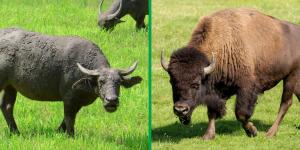Difference Between Turtle Dove vs. Pigeon


The difference between a turtle dove and a pigeon can be seen in both their physical and behavioral characteristics. Differences in size, plumage coloration, tail length, birdsong and their social interaction all help us distinguish between these two birds.
All pigeons and doves, including turtle doves, belong to the family Columbidae. These terms can be a little confusing since they are all the same type of animal. Taxonomically speaking, there is no real difference between doves and pigeons. The differences come when we speak about individual species, with doves usually being somewhat smaller than a pigeon. With more than 300 species in this taxonomic family, it is not surprising some of us can be a little confused. thedailyECO helps to clarify by looking at the difference between a turtle dove vs. pigeon with photos.
D
Doves and pigeons belong to the same family, Columbidae. This is due to their close evolutionary relationship and the many common characteristics they share. They are placed in the same taxonomic family due to their structural, genetic and behavioral similarities. Here are some key reasons why doves, pigeons and turtle doves are grouped together:
- Morphological similarities: doves and pigeons share many physical traits, such as their body shape, beak structure, and feather characteristics. They both have plump bodies, relatively short legs, and a distinctive, slender beak with a soft tip.
- Genetic closeness: genetic studies have confirmed the close relationship between doves and pigeons. Their DNA sequences and evolutionary history align, supporting their placement in the same family.
- Vocalization: both doves and pigeons produce cooing sounds, which are characteristic of the family Columbidae. While the specific vocalizations may vary among species, the cooing behavior is a shared trait.
- Behavior: doves and pigeons exhibit similar behaviors, such as their nesting habits, courtship rituals and feeding preferences. These common behaviors are indicative of their shared evolutionary lineage.
- Rerproduction: both doves and pigeons are known for their monogamous breeding pairs and the production of crop milk, a specialized secretion used to feed their young.
- Ecological niche: doves and pigeons often occupy similar ecological niches, with species found in a wide range of habitats, from woodlands to urban areas. This adaptability is a shared characteristic.
While there are distinctions between various dove and pigeon species in terms of size, coloration and habits, these shared characteristics and evolutionary history unite them in the family Columbidae. When we refer to pigeons, we are likely referring to rock pigeons (Columba livia), the bird that is most commonly referred to as simply a ‘pigeon’.
The turtle dove can refer to various birds of the genus Streptopelia, as well as the mourning dove (Zenaida macroura), which is commonly referred to as a turtle dove. For our purposes in this turtle dove vs. pigeon comparison, we are focusing on the European turtle dove (Streptopelia turtur).
Size
The smaller members of Columbidae are usually called doves, with pigeons generally being larger specimens. Turtle doves are around 8"/20 cm in length, while there are pigeons that reach up to 28"/70 cm. This is a size that corresponds to the largest pigeon called the western crowned pigeon (Goura cristata), although on average, rock pigeons are about 14"/35 cm long.
Turtle doves are more stylized than pigeons. As can be seen in the photo below, they have a more slender body and thinner neck. In comparison, pigeons tend to be more robust.

Behavior
It is common to find pigeons in large flocks of several individuals. This is because they are generally more social with each other. They live together to feed will fly in groups. Turtle doves also form groups to eat, but they are arguably more solitary. They form smaller groups with no more than five individuals per flock. This is where the cultural association of turtle doves with love comes from, since they are almost always seen in pairs. This can be seen in the main photo of this article.
Conversely, pigeons are more aggressive and territorial than turtle doves. Turtle doves are more timid and tend to flee when a threat is presented, rather than confront it as pigeons do.

Shape of wings and tail
The tail of turtle doves opens in the shape of a fan and is long. It takes on a more expressive display, particularly during flight. The wing feathers in turtle doves are also longer in comparison to a pigeon. The feathers of pigeons are arranged in the square-shaped tail, which are both straighter and shorter than that of a turtle dove. The ones on the wings don't stick out that much.
Learn about other similar bird species with our comparison between the swift, the swallow and the house martin.
Color
Pigeons tend to have gray colors with stronger hues and purple, blue and greenish iridescence (see photo below). In comparison, the feathers of turtle doves are lighter and softer in color. Turtle doves also have a distinctive tortoiseshell pattern on their wings. It is from this pattern their common name is derived.

Vocalizations
Turtle doves have a low and soft chirp. When pigeons sing, it is more guttural and louder than turtle doves. In both cases this birdsong serves to communicate with other members of their species.
Learn more about birds that can sing by looking at our article on types of passerine birds. Songbirds make up a large amount of these birds.
You can also hear the difference between pigeon and turtle dove sounds in the two videos below:


If you want to read similar articles to Difference Between Turtle Dove vs. Pigeon, we recommend you visit our Facts about animals category.
- Padilla Álvarez, F., Cuesta López, AE (2003). Applied Zoology . Colombia: Díaz de Santos.








